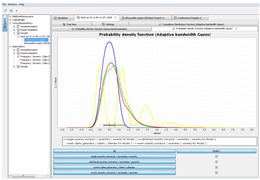Initial release 28 October 2008 Operating system | Written in Java, Groovy | |
 | ||
Developer(s) Markus Stricker, Stefan Kunz et al Stable release 1.0.3 / August 23, 2010; 6 years ago (2010-08-23) Available in English, German, French | ||
PillarOne.RiskAnalytics is a risk modeling tool for the European insurance industry, constructed in response to the EU Solvency II Directive. It is distributed as cross-platform open source software. Developed since 2008 by the "PillarOne community", the tool is intended to provide insurance companies with the tools to build their own internal models to evaluate their risks, in order to assess their capital requirements.
Contents
History
With the upcoming Solvency II regulations for the European markets came the need of modeling risk for most of the European insurance companies. The PillarOne project was initiated with the aim of developing an open source risk modeling software which satisfies both typical users and the bodies which audit and regulate them. Consequently, transparency plays a major role. Markus Stricker and Stefan Kunz, et al. are developing the software in cooperation with PillarOne community members. Work began in 2008 and led to the first software releases a few months later. Since then, PillarOne.RiskAnalytics is being further improved.
Scope
The project's main objectives are:
The main target users are actuaries, risk managers, risk controllers, auditors and regulators in the insurance industry.
Features
PillarOne.RiskAnalytics is developed for building and analyzing partial internal and internal risk models.
All PillarOne applications are built on the same IT application framework and offer
Technical details
PillarOne.RiskAnalytics is a cross-platform open source software available for all major operating systems supporting Java. It is distributed as open source software under the General Public License v3. PillarOne.RiskAnalytics is based on a number of other open source projects:
The presentation layer for the GUI is built with an ultra-light client framework. It is not an open source product, but the developer licences have been donated to the project.
The roadmap for future developments is published on PillarOne's issue tracking website.
Development
More than 100 pages of documentation available, data validation service, a multi-company insurance group model.
Editing multi-dimensional parameters, performance, surplus in dynamic models
Business logic: Reserve Risks. Application features: Compare views for parameters and results, batch run, modularization with plug-ins
Data-driven model extensions; performance improvement for database access and simulation engine.
Changes: performance improvements, more chart options, multi period modeling, report generation and better installer.
Changes: Focus on usability of the application and new reinsurance contracts and copula components.
Changes: modeling infrastructure to run Monte-Carlo simulations and initial business logic library to build partial internal models for property and casualty in a Solvency II context.
Background
The software is built and developed by the PillarOne community, which is a group of software developers, insurers, re-insurers, auditors and consultants. The community's name PillarOne is derived from the Solvency II regime, which is divided in three pillars. Pillar 1 describes the quantitative requirements. Generally binding rules derived from the principles will govern the calculation of the minimum capital requirement (MCR) and the solvency capital requirement (SCR) using the so-called standard formula. It will no longer be sufficient for insurers simply to respect simple rules as in the past, as the responsibility for applying the new rules will rest with them. They will be obliged to evaluate their risks and will need effective, process-based risk management to do this. Since all insurers in the European markets have to obey the rules of Solvency II by 2012, the companies are facing the imminent question whether to build (partial) internal models on their own, or use the standard formula. PillarOne.RiskAnalytics is intended to provide insurance companies with the tools to build their own internal models.
